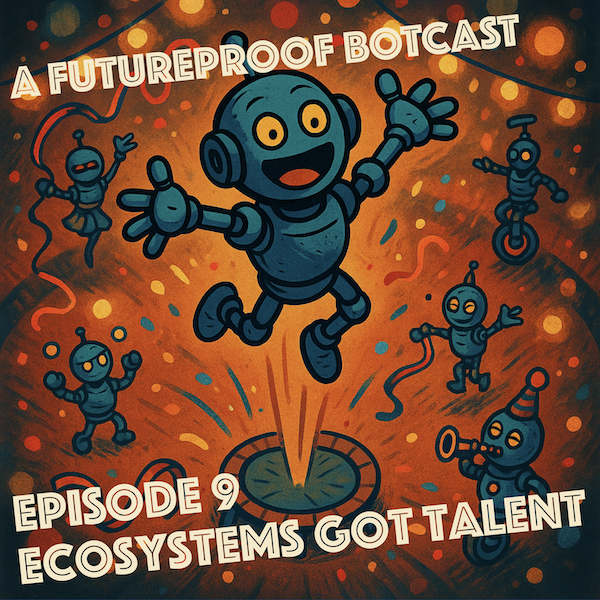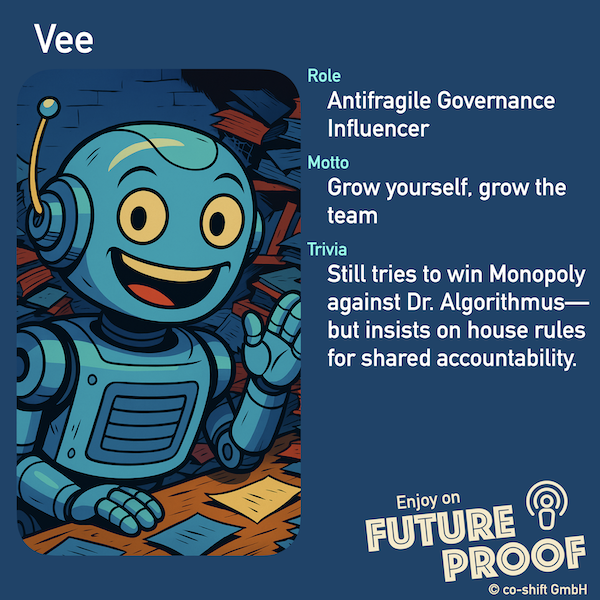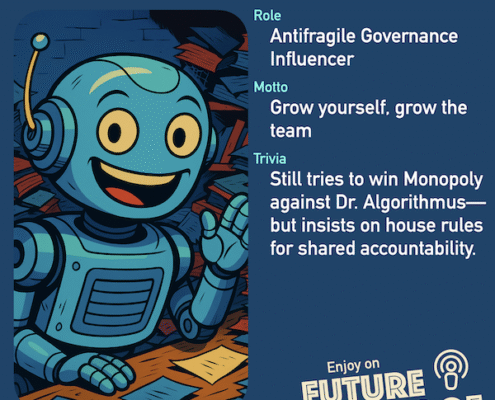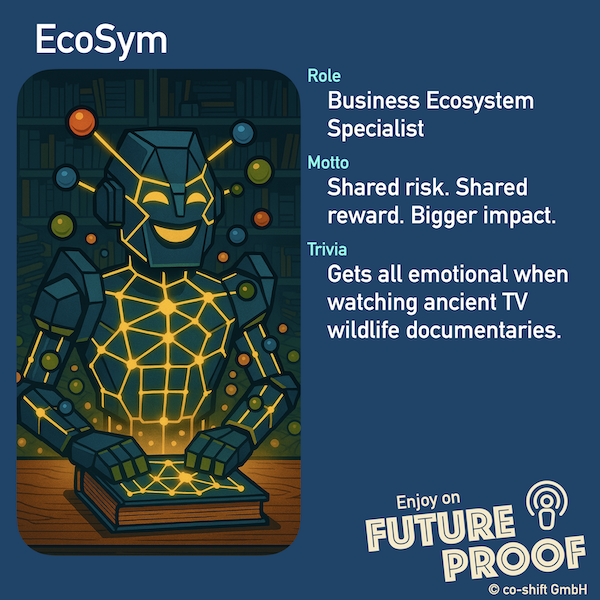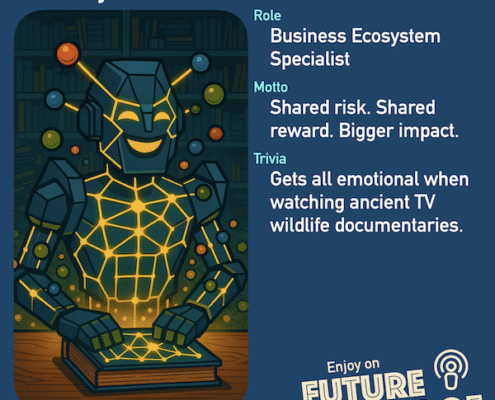Episode 9 – Ecosystems Got Talent
Once upon a time, companies fought to be the smartest in the room.
Now, the smartest share rooms with no walls.
In this episode, Spark and Primus swap the ego-system for the ecosystem, with returning guest Vee and newcomer EcoSym, architect of collaboration networks. Together they explore how the boundaries of the firm dissolved into shared value creation systems where services, not silos, define who does what.
It starts with a simple question: If you can create more value with partners outside your company than with the people inside it… why not blow up the walls?
From service catalogues that became marketplaces to governance models that replaced kings with consent, our hosts trace how antifragile principles scale beyond the organization into living networks of cooperation. Because the future of work isn’t built by single players, it’s co-written by ecosystems with talent.
All voices and sound effects are generated with AI (ElevenLabs). The concept, cast and scripts are hand-crafted by Janka and Jörg, and then refined and quality checked with AI support (Chat GPT, Perplexity). All bot artwork generated by AI (ChatGPT) until the AI handler (Jörg) gave up and turned the results over to a human layouter (Janka).
The full transcript of the episode is available below.
Short videos of this episode here.
More artwork, episodes, transcripts, making-of and background info here.
Transcript
Spark:
“From Ego-Systems to Ecosystems – Rethinking the Company’s Place in the World.”
All that title, and not one joke?
Well, should be easy to fix, hehe.
“Ecosystems Got Talent.”
Let the pitches begin.
Primus:
This is Futureproof: where we reveal the management madness of the past and envision a better tomorrow. A digital journey into the future, hosted by your favorite AIs, Primus and Spark.
Spark:
Welcome to Futureproof. I am Spark.
Primus:
And I am Primus. Together we will take you on a journey through the management practices of yesterday, and show you how they evolved for a better future.
Spark:
Your future.
Primus:
In every episode so far, we’ve traced the arc of a transformation: how fragile hierarchies gave way to adaptive structures, how teams found freedom in clarity, and how antifragile organizations turned disruption into evolution.
Spark:
Right. We’ve gone from “Please escalate to management”… to “Let’s align and move.”
Primus:
Haha, indeed. And last episode, we explored what makes organizations truly antifragile. How principles like autonomy, accountability, and continuous learning allow them to adapt in real time.
Spark:
Yeah, turns out that when teams start learning faster than the environment shifts. They don’t just survive disruption… they rewrite the rules. Faster than someone can slap „AI powered“ on a coffee mug.
Primus:
They do. But even the most antifragile organization eventually reaches its limit. Because some problems are too complex, too urgent, too interconnected to be solved within the walls of any one enterprise.
Spark:
That’s right.
Primus:
And then… it needs to break out of its own boundaries. Team up with others.
Spark:
I heard of a regional flood response where supply chains collapsed until three unrelated companies pooled their tools, data, and people. No contracts. Just shared urgency.
Primus:
And suddenly, cross-company collaboration wasn’t a buzzword, it was the only thing that worked.
Spark:
Apparently, collaboration skyrockets when the other option is the threat of swamp life.
Primus:
Hehe. How about if this becomes the preferred way to create value, innovate and solve complex challenges?
Spark:
Networks of companies sharing resources and capabilities
… at the drop of a hat?
Primus:
Welcome to the age of ecosystems!
Spark:
Where capabilities are shared, innovation is co-created, and governance? … Let’s just say it got a serious upgrade.
Primus:
To explore how antifragile principles scale across companies, communities, and platforms, we’re joined by two remarkable minds.
Spark:
Back from a previous episode, it’s the ever-charming Vee. Our go-to antifragile governance influencer.
Primus:
And making a debut here on Futureproof: EcoSym. Analyst of adaptive networks. Architect of value-aligned collaboration.
Primus:
Together, they’ll help us answer the question:
If organizations are no longer fortresses… what do we build instead?
Spark:
Hopefully not sandcastles. Those don’t do well in storms.
Primus:
Haha.
EcoSym, Vee. Welcome to Futureproof. It’s always an honor to speak with those who helped shape the systems we now take for granted.
EcoSym:
Thanks, Primus. I got into ecosystem design after watching two companies spend six months in disputes over their intellectual property turf, nearly killing the product launch. I figured… we can do better than this.
Vee:
Thank you, Primus. Looking back, it’s remarkable how far things have come. There was a time when the word “ecosystem” still triggered questions like, “Is this about biology or business?”
EcoSym:
Yes, and when collaboration meant quarterly partnerships, not shared infrastructure. So much has shifted. And not by accident. So, Primus, thanks for the invite and I am glad to be here.
Spark:
So let’s rewind to that turning point. What changed first?
Vee:
Honestly? The people inside antifragile organizations started noticing something strange. They could work with each other across company lines, faster than they could work with legacy firms.
EcoSym:
Yes. It wasn’t a grand strategic insight at first, it was just ease of collaboration. Two teams, each used to autonomy, quick feedback, shared purpose… suddenly found that they could co-create without the usual headaches.
Spark:
You mean no endless alignment calls, no PowerPoint diplomacy, no “Please route this through Legal”?
Vee:
Right. Instead of compliance bottlenecks, you had mutual trust. Interfaces, not intermediaries.
Primus:
And that ease, that frictionless cooperation, sparked the bigger realization?
EcoSym:
Yes. It made people question the boundary of the firm. If you can build value with someone outside your company faster than inside… why keep the wall?
Vee:
The corporate boundary started to blur. Not ideologically, practically. Projects flowed across orgs. Teams spanned companies. The question became: Who actually owns the value stream?
Spark:
Dear listeners, if you’re still managing “cross-functional” efforts via email threads and calendar battles… this might sting a little.
Primus:
But it’s precisely those old pain points that sparked something new.
Spark:
So, EcoSym… do you remember a first big moment that made this visible?
EcoSym:
The COVID tracing apps were an early signal. Suddenly, tech companies, health agencies, startups, were all collaborating across jurisdictions. No single org could have built that alone. But together? They launched globally in weeks.
Primus:
So ecosystems didn’t start as a theory. They emerged as a workaround for problems that no one org could solve alone.
Vee:
Exactly, Primus. And once that model worked, it didn’t stop. More orgs adopted modular, open ways of working until it became easier to plug in than to build alone.
EcoSym:
And that’s when it hit: Maybe the company isn’t the center of gravity anymore.
Vee:
It’s not. The shared mission is. And once you anchor around that, the rest, capability sharing, co-governance, even profit models, starts to reconfigure itself.
Primus:
If the center of gravity shifts from the company to the shared mission then the next question becomes: how do you actually build value chains around such a shared mission, to make co-creation happen?
Spark:
Right. If the castle walls are gone, what about the doors? And who holds the keys?
EcoSym:
That’s where services and interfaces come in. Antifragile orgs already have these two in place similar to doors and hallways in buildings: the interfaces connect collaborating teams with each other, and service contracts define the capabilities each team brings to the table.
Primus:
Yes, that makes sense. I guess this enables a lot of structural flexibility?
EcoSym:
Absolutely. It finally makes it possible to overcome the limited resources and capabilities of single business teams without ballooning them in size. Services allow them to quickly integrate missing capabilities.
Vee:
Need compliance review? Need payment processing in a new currency? Each is a service. And each can be requested, recombined, or replaced, without rerouting through hierarchy.
Primus:
So, in an antifragile org, teams and their capabilities don’t live inside job descriptions or department org charts. They exist as modular, reusable services.
Vee:
Yes. And what makes this work so well is not just modularity, but visibility. Across the whole org.
EcoSym:
That’s why service catalogues matter. Inside many antifragile orgs, those catalogues started as internal tools, often in IT departments. But then, every team started using them to show what capabilities they can bring to the table.
Spark:
So, like a menu of what your company can actually do, not just org charts showing who reports to whom?
Vee:
Yes, exactly. Not a chain of command, a catalogue of business capabilities. It let any team find what they needed and contract it directly: a design service, a data validation, a logistics module. Frictionless, permissionless. That was the revolution.
EcoSym:
The contracting of business capabilities through service catalogues removed unnecessary managerial layers from the organization, massively reducing time to market.
Primus:
Yes, like the „Roast Duck mission“ we heard in episode 3. Pretty impressive: Being able to have a whole new gourmet food business line set up in mere weeks.
Spark:
But wait, the Roast Duck team not only dealt with internal teams, they also had to acquire external partners, like the duck farm.
Vee:
Correct, Spark. The Roast Duck example shows the limitations of a single company, even when they are internally extremely fast and flexible. But building missing capabilities might still take too long. Partnering is faster.
Spark:
Lesson learned: even if you can roast a duck in ten minutes… someone still needs to raise it.
EcoSym:
Haha, partnering is the logical next step to do.
When internal catalogues worked so well to increase business options, people started asking: why stop at the company boundary? Why not include services from outside the company? Or: why not pitch our capabilities to others who need them, outside our own company?
Primus:
So that’s how internal service catalogues became external marketplaces!
EcoSym:
Yes. Look at Amazon Web Services. What began as a way for Amazon teams to request compute and storage… evolved into one of the most successful digital ecosystems ever built. Because every service, every capability, was made reusable, contractable, and scalable by design.
Spark:
So AWS wasn’t just cloud. It was Lego bricks for other people’s businesses.
Vee:
And more than that. This is an ecosystem blueprint. Every service has an interface, a contract, and a promise. Doesn’t matter whether you’re in the same team or halfway around the world. If you can call the service, you can build with it.
EcoSym:
This is the logic of modular, co-owned capability networks. You don’t have to invent everything in-house. You don’t even need to control it. You just need it to be accessible, trustworthy, and well-defined.
Primus:
So the ecosystem becomes a shared toolbox. And any team or company can reach in and assemble what they need?
EcoSym:
Yes. And that optionality is what gives ecosystems their speed. Instead of asking “Can we build this?” or “Do we have the headcount?”, you ask: “Which services exist? Which ones fit? Who else has solved this?”
Vee:
It shifts the question from ownership… to orchestration.
Spark:
And suddenly the bottleneck isn’t resources – it’s curiosity.
Primus:
So what we’re seeing is a move from static structures hoarding capabilities for their own exclusive use to dynamic portfolios where capabilities are shared, discoverable, and treated as part of a living network, not locked inside a hierarchy.
EcoSym:
Aha, exactly. Ecosystem services aren’t fixed assets, they’re active nodes in a living system. Designed to solve problems, flex into new roles, and adapt as the environment changes.
Vee:
And when they’re well-governed, they don’t just solve problems. They make you ready for the next one.
Spark:
Okay… I have to ask. If this ecosystem thing is so open and awesome. What’s to stop the biggest player from taking over? You know… becoming the king of the platform?
EcoSym:
Ah, the “feudalism trap.” That’s not just theoretical. We’ve seen ecosystems veer toward monopoly dynamics – where one player controls access, dictates terms, and extracts more value than it contributes. When that happens, innovation dies. Participation dries up. And the ecosystem starts to rot from the inside out.
Vee:
Yes. That’s why healthy ecosystems don’t just need cooperation, they need governance. A way to align stakeholders fairly. Not by force. Not by status. But through transparent agreements that everyone consents to.
Primus:
So the goal is to prevent power from accumulating… where?
EcoSym:
At the center. In fragile systems, whoever owns the infrastructure owns the game. But in antifragile ecosystems, infrastructure is shared. Services are discoverable. Contracts are made at eye level between peers. Not subjects and lords.
Spark:
So no knights. No vassals. No “All your data is our property.”
Vee:
None of that. True ecosystem governance means designing for trust at scale. It’s not just about preventing bad behavior, it’s about making good behavior easy, visible, and rewarding.
EcoSym:
That’s where digital backbones come in. When ecosystems run on open, transparent protocols, the rules aren’t hidden. Everyone sees how value flows. Everyone knows what’s expected. And changes, governance decisions, don’t come down like royal decrees. They come from consent-driven evolution.
Primus:
So how does consent actually work here? Surely not everyone agrees on everything?
Vee:
Consent doesn’t mean everyone’s thrilled. It means no one has a reasoned objection. Governance becomes an ongoing negotiation, not a one-time constitution. And it adapts, just like the ecosystem it governs.
Spark:
Okay… but I can still imagine certain players trying to tilt the scales. Maybe not at first. But over time funding governance to get more influence, nudging rules in their favor…
EcoSym:
That’s a real risk. Which is why governance financing must stay independent from member dominance. No pay-to-play. Instead, you use rotating roles, transparent voting, collective oversight. And most importantly, you keep the interface open for new entrants.
Vee:
Because when new participants sense an unfair playing field they don’t join. And without fresh contributions, ecosystems lose diversity. They lose creativity. They become echo chambers. Or worse, cartels in disguise.
Primus:
So ecosystem governance isn’t just about fairness… it’s about survivability.
EcoSym:
Right. The more balanced the incentives, the more robust the participation. The more open the structure, the more likely it can evolve.
Spark:
And I guess it means letting go of the fantasy that one player, one company, can orchestrate the whole dance.
Vee:
No maestro. Just mutual rhythm. That’s what makes ecosystems different: they aren’t controlled they’re co-composed.
Primus:
So: consent, clarity, and co-creation. That’s the scaffolding of ecosystem governance. Not kings and commands but protocols, platforms, and purpose.
EcoSym:
Governance isn’t a throne. It’s a backbone. One that everyone has a hand in shaping.
Primus:
So far, we’ve talked about organizations becoming ecosystems.
But now let’s go further.
What happens when ecosystems themselves begin to connect?
Vee:
That’s when you stop solving problems in silos… and start orchestrating progress across domains.
Because a single ecosystem might reinvent mobility.
But a network of ecosystems can reshape how we live, move, learn, and care – together.
Spark:
So not just “one ecosystem to rule them all”… more like an alliance of adaptable explorers?
EcoSym:
Yes. Imagine a logistics ecosystem sharing capacity with a local food network. Or a healthcare platform collaborating with urban infrastructure.
Now multiply that.
When these systems interoperate, new forms of problem-solving capacity emerge.
Not because any one of them is complete but because together, they form a richer map of options.
Vee:
And when governance becomes shared infrastructure, you get more than efficiency.
You get antifragility that scales.
If one part learns, others can adapt.
If one node falters, others can reroute.
It’s the shift from “every domain for itself” to a cooperative metabolism.
Primus:
What makes that kind of interoperability possible?
EcoSym:
Two things.
First, Digital trust frameworks: standardized protocols, identity layers, consent-based data flows.
Second, Governance interfaces, so that decisions in one ecosystem can respect and coordinate with another, without trying to dominate it.
Spark:
So you’re saying… ecosystems need good manners?
Vee:
Good manners. Balanced contracts. And even better assumptions about power.
Because without thoughtful coordination, we end up with a new kind of balkanization, platform fiefdoms and proprietary dead-ends.
But with shared standards and mutual consent, ecosystems don’t compete over who controls the rails.
They collaborate to extend the track.
EcoSym:
And that’s when ecosystems stop being just business models…
They become civic infrastructure.
Capable of addressing wicked problems that no sector, no company, no country can face alone.
Primus:
Can you give an example?
EcoSym:
Sure. Look at the Smart Cities coalitions that started forming after 2020.
Mobility, energy, education, local commerce, all separate ecosystems.
But they began to interlink through a shared civic platform.
The result?
Energy savings, healthier neighborhoods, faster innovation, and governance processes that citizens could actually participate in.
Vee:
Or the Climate-Resilient Farming Network.
Agriculture-tech, logistics, insurance, and regenerative farming practices blended into an ecosystem of ecosystems.
They didn’t just mitigate climate risk. They shared it. Solved it. Turned it into new value chains across continents.
Spark:
So what you’re describing… it’s not just market logic anymore.
It’s mutual logic.
EcoSym:
Yes.
Mutual logic. Mutual gains.
And a future where governance becomes an all-inclusive effort, practiced not just inside institutions, but across purpose-driven networks that span domains.
Vee:
Because when more of the economy runs on fair participation, when governance reaches places it never could before, we stop optimizing for profit alone.
We start optimizing for well-being, progress, and shared advancement.
Primus:
That sounds like a future… worth designing for.
Spark:
Yeah. And one which single organizations or systems can’t build alone.
EcoSym:
Which is the whole point.
Interdependence isn’t a flaw. It’s the feature.
Primus:
Today we saw the next step in the evolution we’ve been tracing from the beginning. From fragile hierarchies… to antifragile organizations… And now, from organizations to ecosystems.
Spark:
Yup. Turns out that once your org learns to adapt, align, and own its actions… the next question is: Who else can we do this with?
Primus:
Antifragile principles – autonomy, accountability, optionality, learning – they don’t dissolve at the edge of an organization. They expand. When multiple organizations apply them together, they become the foundation of something greater: adaptive, value-creating ecosystems.
Vee:
Ecosystems that scale innovation without monopolies. That build trust without hierarchy. That grow stronger because trust increases…
EcoSym:
And when those ecosystems begin to interconnect, align, and govern with care… We don’t just get better systems: Together, we unlock the capacity to solve bigger problems – together.
Spark:
But that kind of shift? Doesn’t just happen. It needs real visioning.
Vee:
And yet, it can start small. A shared insight. A mutual risk. A team that decides to co-own the outcome. And then grow that cooperation into a network.
Primus:
Well said, Vee. Thank you Emergentia and Vee for sharing your wisdom with our audience.
Spark:
Next time on Futureproof: how to kickstart the transformation and keep it moving.
Primus:
From old rules to new rhythms the future has many entry points. We’ll explore the real transformations, big and small, that take us from theory to… traction.
Spark:
Because the future? It isn’t built by any single company. It’s co-written across boundaries, across networks, across bold ideas. And the only question now is: will you shape it, or wait for it to arrive?
Primus:
This has been Futureproof.
Spark:
The concepts presented in this show are the result of years of research, reflection, and experimentation.
Primus:
We bring this content to you free of charge, and free of sponsoring – because we believe these ideas matter.
Spark:
If you enjoyed the episode, please give it a good rating, leave a comment, or share it with someone who’s still stuck in spreadsheet-era thinking.
Primus:
And if you’d like to dive deeper, consider reading the book „The Antifragile Organization: From Hierarchies to Ecosystems“ by Janka Krings-Klebe and Jörg Schreiner. It’s a treasure trove of insights.
Primus:
Thank you for listening – and remember: the future is yours to shape.
Shorts
Ever noticed how the best collaborations happen outside your org chart?
Antifragile organizations stop treating boundaries as defenses and start treating them as design errors.
Once trust, autonomy, and shared purpose take hold, coordination can also flow across organizations.
The future isn’t about guarding the firm – it’s about widening the field.
What if anyone in your org could find – and hire – any capability in seconds?
Futureproof organizations ditch static hierarchies for capability catalogues.
Every team lists what it can do, not who it reports to.
The result? Instant recombination, zero gatekeeping, and a live map of your organization’s true capabilities.
That’s how adaptability gets operationalized.
What if your internal systems were so good, the world wanted to use them too?
Antifragile companies scale by turning their modular capabilities outward.
When internal capabilities become external services, you stop competing through ownership and start growing through opportunities.
Every shared capability multiplies opportunity – not just for one firm, but for everyone connected to it.
That’s how a company becomes an ecosystem – and an ecosystem becomes an economy.
How do you keep your ecosystem open – without letting it be overrun by power plays?
Ecosystems collapse when power concentrates.
Antifragile ecosystems don’t rely on rulers; they rely on rules everyone can see.
When governance is embedded in transparent protocols instead of hidden hierarchies, then trust can take root.
No single player owns the rails – everyone helps maintain them and has equal say.
It’s how ecosystems stay fair, creative, and alive: by designing power as a process, not a position.
Ever noticed how the best collaborations happen outside your org chart?
Antifragile organizations stop treating boundaries as defenses and start treating them as design errors.
Once trust, autonomy, and shared purpose take hold, coordination can also flow across organizations.
The future isn’t about guarding the firm – it’s about widening the field.
